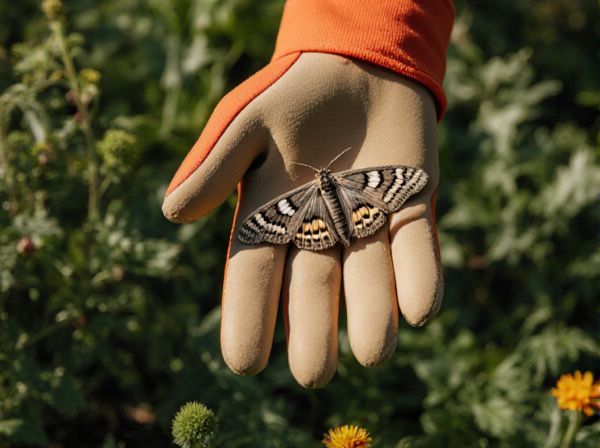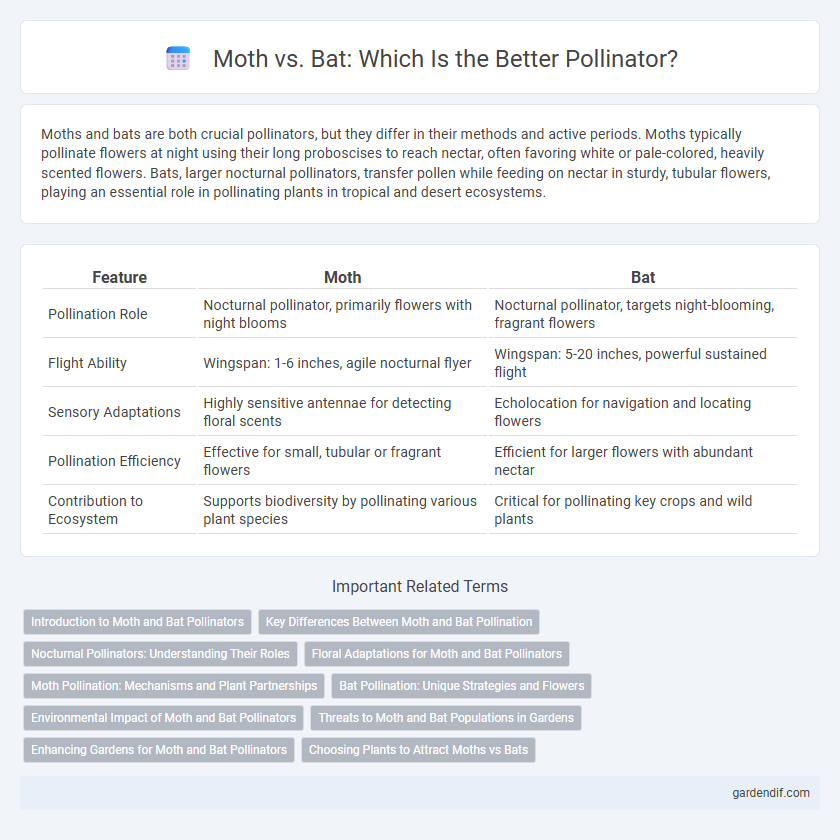
Moth vs Bat Illustration
Moths and bats are both crucial pollinators, but they differ in their methods and active periods. Moths typically pollinate flowers at night using their long proboscises to reach nectar, often favoring white or pale-colored, heavily scented flowers. Bats, larger nocturnal pollinators, transfer pollen while feeding on nectar in sturdy, tubular flowers, playing an essential role in pollinating plants in tropical and desert ecosystems.
Table of Comparison
| Feature | Moth | Bat |
|---|---|---|
| Pollination Role | Nocturnal pollinator, primarily flowers with night blooms | Nocturnal pollinator, targets night-blooming, fragrant flowers |
| Flight Ability | Wingspan: 1-6 inches, agile nocturnal flyer | Wingspan: 5-20 inches, powerful sustained flight |
| Sensory Adaptations | Highly sensitive antennae for detecting floral scents | Echolocation for navigation and locating flowers |
| Pollination Efficiency | Effective for small, tubular or fragrant flowers | Efficient for larger flowers with abundant nectar |
| Contribution to Ecosystem | Supports biodiversity by pollinating various plant species | Critical for pollinating key crops and wild plants |
Introduction to Moth and Bat Pollinators
Moth pollinators primarily operate during twilight and nighttime hours, using their sensitive antennae to detect floral scents and locate nectar-rich flowers. Bat pollinators, especially nectar-feeding species like the glossophagine bats, play a crucial role in the pollination of large, nocturnal flowers that emit strong fragrances and produce abundant nectar. Both moths and bats contribute significantly to the reproductive success and genetic diversity of various plant species through their specialized pollination behaviors.
Key Differences Between Moth and Bat Pollination
Moth pollination typically occurs during nighttime with moths using their long proboscis to access nectar from deep, tubular flowers, while bats pollinate by hovering and using their tongues or snouts to collect nectar from larger, more robust blossoms often emitting strong, musky scents. Moths are attracted to pale or white flowers that reflect moonlight, whereas bats prefer flowers that are often dull in color but have a strong, fruity or fermented odor to guide them. The ecological roles differ as moths mainly pollinate smaller plants, while bats facilitate pollination for larger trees and plants in tropical and subtropical regions, contributing significantly to forest regeneration.
Nocturnal Pollinators: Understanding Their Roles
Moths and bats are vital nocturnal pollinators that contribute significantly to the reproduction of many flowering plants. Moths primarily pollinate night-blooming flowers with strong fragrances, while bats specialize in pollinating larger, tubular blossoms and play a crucial role in tropical ecosystems. Understanding their complementary pollination roles helps preserve biodiversity and supports ecosystem resilience.
Floral Adaptations for Moth and Bat Pollinators
Floral adaptations for moth pollinators include pale or white petals and strong, sweet scents emitted at night to attract nocturnal moths, whose long proboscises access deep nectar tubes. In contrast, bat-pollinated flowers typically exhibit large, sturdy structures with muted colors like green or white, emit a musky or fruity odor, and produce abundant nectar to accommodate bats' robust bodies and high energy demands. These specialized traits enhance effective pollination by aligning flower morphology and chemical cues with the sensory and feeding behaviors of moths and bats.
Moth Pollination: Mechanisms and Plant Partnerships
Moth pollination relies heavily on nocturnal activity and strong olfactory cues emitted by flowers, attracting these insects through scent compounds such as benzyl acetate and linalool. Many moth-pollinated plants, like the yucca and evening primrose, have evolved pale-colored, tubular flowers with abundant nectar to accommodate the long proboscis of moths. This specialized plant-pollinator interaction supports biodiversity and enhances the reproductive success of both moths and flowering plants in various ecosystems.
Bat Pollination: Unique Strategies and Flowers
Bat pollination, or chiropterophily, involves nocturnal flowers that emit strong fragrances and produce copious nectar to attract bats as primary pollinators. These flowers often have large, sturdy petals and pale or white colors, enhancing visibility in low light conditions. Bats use echolocation to locate these blooms, facilitating pollination in ecosystems where moths are less effective due to different foraging behaviors.
Environmental Impact of Moth and Bat Pollinators
Moth pollinators contribute significantly to the nocturnal pollination of various wild plants and agricultural crops, supporting biodiversity and ecosystem stability. Bat pollinators enhance the regeneration of tropical forests by transferring pollen over long distances, which aids genetic diversity and carbon sequestration. Both moths and bats play crucial roles in maintaining healthy ecosystems, with bats particularly impacting large-scale forest environments while moths predominantly support undergrowth and smaller plant species.
Threats to Moth and Bat Populations in Gardens
Moth populations in gardens face threats from light pollution, which disrupts their nocturnal navigation and reduces their pollination efficiency. Bat populations are increasingly impacted by habitat loss and pesticide use, which diminish their insect prey and roosting sites. Declining numbers of both moths and bats jeopardize the pollination of night-blooming plants, undermining garden biodiversity.
Enhancing Gardens for Moth and Bat Pollinators
Moths and bats play crucial roles as nocturnal pollinators in diverse garden ecosystems, each attracted to different floral traits that enhance pollination efficiency. Planting night-blooming flowers with strong fragrances and pale colors like moonflowers or evening primroses supports moth activity, while integrating native fruit trees and large, open flowers caters to bat pollinators. Creating a habitat with a combination of these plants and maintaining natural water sources fosters a thriving environment for both moths and bats, increasing biodiversity and garden resilience.
Choosing Plants to Attract Moths vs Bats
Selecting plants to attract moths involves choosing night-blooming species with strong, sweet fragrances and pale-colored flowers such as evening primrose or jasmine. In contrast, attracting bats requires planting native fruiting trees like fig or guava, along with flowering plants that produce abundant nectar such as agave or trumpet vine. Understanding the distinct feeding behaviors and sensory preferences of moths and bats helps optimize garden design for effective pollination.
Moth vs Bat Infographic

 gardendif.com
gardendif.com